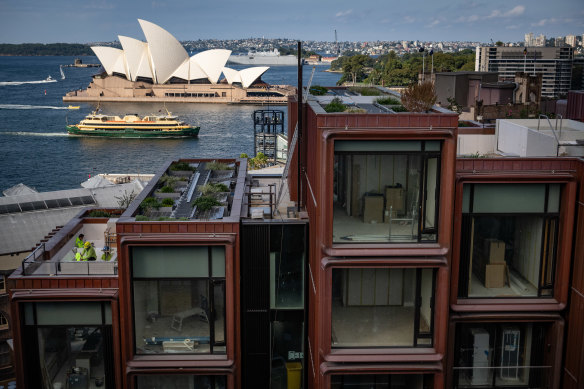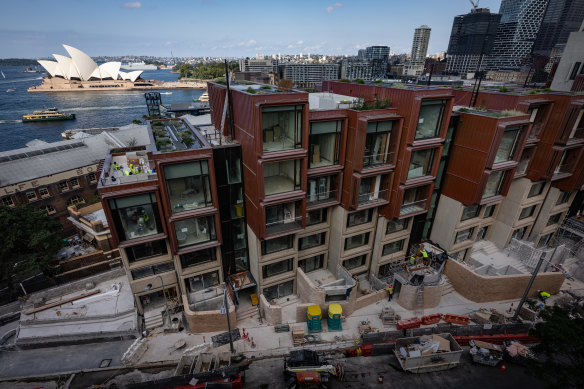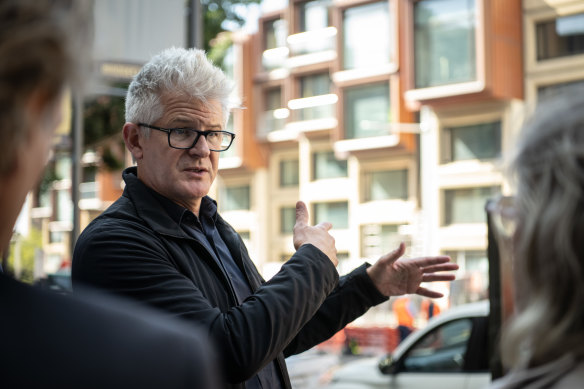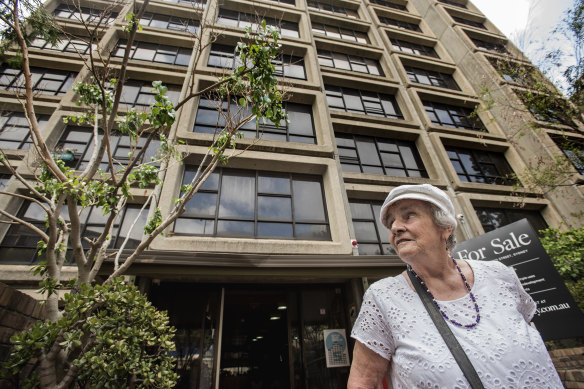This was published 1 year ago
Love it or hate it, Sirius lives to tell a new chapter in Sydney’s history
For those who fought to save the Brutalist building in the Rocks as public housing, there is no forgiving its sell-off. But the updated building has the thumbs up from leading architects.
By Julie Power

The Sirius is being redeveloped into luxury apartments.Credit: Wolter Peeters
The controversial conversion of the former public housing block Sirius into luxury housing was never going to slip under the radar, with its new copper living pods visible to anyone heading south on the Sydney Harbour Bridge.
To be completed in June at a cost of about $150 million, the conversion of the 79 public housing flats into 75 high-end apartments – topped by a penthouse now selling for $50 million – was the most complex project undertaken by its builders, architects and developer.
“You’ve heard of cookie-cutter design? This is the complete antithesis,” said Benjamin Wilderink, the project manager with Richard Crookes Construction. Of 25,000 apartments previously delivered by the builder, Sirius was the most bespoke. No two apartments are alike.
Sirius has always been one of Sydney’s most divisive buildings, an eyesore to the haters. The former premier Dominic Perrottet said Sirius was as sexy as his local parking lot, and thought it should be razed.
Its survival could be called the revenge of the “concrete monsters”, the term that lovers of Brutalist architecture used to describe the unadorned exteriors.
Now undergoing its internal fit-out, the three-year renovation and restoration by award-winning architects BVN has retained the original concrete, kept most of the original building, replanted gardens and updated a local park.
Phillip Rossington, a principal with BVN – which won a design competition to adapt the building – said his firm took on the project only because of a commitment by developer JDH Capital to save the building. The NSW government sold it to JDH for $150 million in 2019.
From the outset, BVN decided to add concrete pods clad in $2 million worth of copper, clearly identifying the new additions, and prepare the building for a long future.
“We wanted a noble material that would age with the building,” Rossington said of the copper. “It will be there way, way, way beyond any of us, rather than a building that in 20 years time looks faded and a bit sad.”

The soon to be completed Sirius building in the Rocks.Credit: Wolter Peeters
The simplicity of the building’s stepped exterior – resembling a pile of blocks rising to a peak – belied its complicated plan, he said.
“Everybody believes this is an amazing modular building. The only thing modular about the building was the concrete precast facade. Everything’s different,” he said.
Original architect Tao Gofers had delivered made-to-measure housing and harbour views, catering for families of different sizes and people with disabilities among its former 100-odd working-class tenants in 1980.
And its original design couldn’t have been more different from conventional blocks, in which apartment layouts are repeated.
Rossington said this aspect made the project more fun and interesting than conventional apartment blocks.
The gross floor area was increased from 6538 square metres to 8316. The original ceiling height of 2.4 metres was retained in many apartments.

The redevelopment of the Sirius building is nearing completion. Phillip Rossington, a principal with architects BVN, says they have kept the structure of the Sirius and its history. Credit: Wolter Peeters
BVN stuck to the original plan, but Rossington said they turned “English style” small rooms – separate kitchens and living rooms – into open plan with views in both directions.
To improve public access to the site, BVN and JDH funded an accessible public lift in The Rocks, open around the clock from Playfair Street via the Cleland Bond building, and revived a colonial path, Gloucester Walk, that few wanted to use after dark.
They added a passage through the Sirius site where the public can look into the famed Phillip communal meeting room.
Rossington said of the most typical arrangements, 30 two-bedroom split-level apartments, “No two of them are the same.”
Levels vary, while vertical and horizontal surfaces differ in dimension. No two bathrooms are identical and each window – and blind – is a different size.
Why did BVN take on such a controversial project?
Rossington recalled driving between Sydney and his home near Newcastle in the 1970s and ’80s and marvelling at the construction of the Sirius and the lush gardens softening its Brutalist exterior.
He was still crossing the Harbour Bridge when the developer asked BVN to prepare a design, but by then he had watched its gardens die, the tenants moved by the NSW government and the building fall into disrepair. The government later refused to heritage list the building.
“We saw that the Sirius had a rich history. We couldn’t have an impact on what had happened, but we could help save the building and tell its story going forward, that it was a building before our copper boxes were added.”
Over the years, he saw proposals to upgrade or renovate the building that would have destroyed Sirius.
“What’s the point of keeping the building if you add curvy balconies to it and paint it a shiny gleaming white? You may as well as [demolish it] because you have taken away its Brutalist character. We felt that we could assist in saving the building, and show the building and the site’s history.”

Artists images of the Gloucester walk. Credit: BVN
Rossington cited London’s Barbican, also in the Brutalist style, as “a really good example of a building that people either hated or loved ... rejuvenated to become something that is probably richer than it ever was before”.
The Sirius project has nearly sold out. Eight apartments of two or three bedrooms will be released soon, priced from $1.5 million to $3 million.
Given the location and harbour views, Rossington said, any apartments there would have been expensive.
Carter Williamson’s Shaun Carter, a former president of the NSW chapter of the Institute of Architects who led the fight to save Sirius, said they lost the war but won a few battles.
“We stopped it from being razed,” he said. “We always argued that you either love Sirius or hate Sirius, but you cannot deny it’s as a cultural vessel.
“People will point to it, and say that used to be the best public housing in Sydney. And now it’s the most expensive housing in Sydney. And that is a diametrically juxtaposed position.”
Architect Philip Vivian, the managing director of Bates Smart, said BVN had “done an amazing job architecturally, and it’s very respectful of the heritage”.

Myra Demetriou was the last public housing tenant to leave the Sirius in 2018Credit: Steve Siewert
“It’s easy to blame the architect or the developer for what’s happened there, but I don’t think that’s fair. They were responding to a government brief that says, ‘We’re going to sell this to whoever offers us the most money.’
“The error in everything that happened at Sirius sits with the government. Why did they put up for sale a block of land that contained people’s homes? They saw it as real estate, but it contained homes for disadvantaged people.”
Ben Peake, who worked on the Save Our Sirius campaign and cowrote a book on the fight, said he hoped to be able to “see past what society did” and appreciate the architecture.
“I am one of those people who have always liked the Sirius building. And so I think I’ll be able to continue to like it as a piece of architecture and adaptive reuse.”
John Green of DEDICO, a project management firm engaged by the developers, said the design, the original by Gofers and the update by BVN, was attractive to buyers who didn’t want a conventional glass apartment.
“Love it or hate it, this is a new version of it. Everybody’s talking about it, and I get architects who say, ‘You have done a fantastic job,’ ” he said.
Start the day with a summary of the day’s most important and interesting stories, analysis and insights. Sign up for our Morning Edition newsletter.